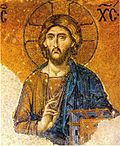- Epistle to Diognetus
-
Part of a series on Eastern Christianity 
History Orthodox Church History
Specific regions:
Byzantine Empire
Ecumenical council
Christianization of Bulgaria
Christianization of Kievan Rus'
East-West Schism
Asian Christianity
Coptic Egypt · UkraineTraditions Orthodox Church
Others:
Oriental Orthodoxy
Ethiopian Tewahedo Church
Coptic Church
Church of the East
Eastern Catholic Churches
Syriac ChristianityLiturgy and worship Sign of the cross
Divine Liturgy
Iconography
Asceticism
OmophorionTheology Hesychasm · Icon
Apophaticism
Filioque clause
Miaphysitism
Monophysitism
Diophysitism
Nestorianism
Theosis · Theoria
Phronema · Philokalia
Praxis · Theotokos
Hypostasis · Ousia
Essence vs. Energies
MetousiosisThe Epistle of Mathetes to Diognetus (Greek: Πρὸς Διόγνητον Ἐπιστολή) is probably the earliest example of Christian apologetics, writings defending Christianity from its accusers. The Greek writer and recipient are not otherwise known, but the language and other textual evidence dates the work to the late 2nd century; some assume an even earlier date and count it among the Apostolic Fathers.
Contents
Author and audience
"Mathetes" is not a proper name; it simply means "a disciple." The writer is a Johannine Christian who does not use the name "Jesus" or the expression the "Christ" but prefers the use of "the Word."[1]
Diognetus was a tutor of the emperor Marcus Aurelius [2], who admired him for his freedom from superstition and sound educational advice. [3]
Manuscripts
The Epistle survives in two manuscripts. A third, that survived until 1870, was in a 13th century codex that included writings ascribed to Justin Martyr. The other two are probably copied from this. It was at Strasbourg but was burned there during the Franco-Prussian War. Fortunately it had already been printed, the first time in 1592, when it was generally ascribed to Justin Martyr because of the context of its manuscript. In all manuscripts, about two lines of the text are missing in the middle. The 13th century manuscript was obviously damaged in that place and the copies were made only after that damage had already been done.
Contents
The Epistle is in twelve chapters:
- Chapter I.-Occasion of the Epistle.
- Chapter II.-The Vanity of Idols.
- Chapter III.-Superstitions of the Jews.
- Chapter IV.-The Other Observances of the Jews.
- Chapter V.-The Manners of the Christians.
- Chapter VI.-The Relation of Christians to the World.
- Chapter VII.-The Manifestation of Christ.
- Chapter VIII.-The Miserable State of Men Before the Coming of the Word.
- Chapter IX.-Why the Son Was Sent So Late.
- Chapter X.-The Blessings that Will Flow from Faith.
- Chapter XI.-These Things are Worthy to Be Known and Believed.
- Chapter XII.-The Importance of Knowledge to True Spiritual Life.
The 10th chapter breaks off in mid thought and so the last two chapters, a kind of peroration that abandons the (fictive?) epistolary formula, are often considered to be later additions as characteristically 3rd-century contentions appear in them: "This Word, Who was from the beginning...". Some have ascribed these additions to Hippolytus, based on similarities of thought and style. In the 11th chapter "Mathetes" presents himself as "having been a disciple of Apostles I come forward as a teacher of the Gentiles, ministering worthily to them" placing himself in a class with authoritative figures like John the Presbyter.
Literature
- Lona, Horacio E.: "An Diognet", Übersetzt und erklärt, ed. by N. Brox, K. Niederwimmer, H. E. Lona, F. R. Prostmeier, and J. * Ulrich. (Series: Kommentar zu frühchristlichen Apologeten, KfA, Vol. 8). Verlag Herder: Freiburg u.a., 2001. ISBN 3-451-27679-8
- Foster, Paul. "The Epistle to Diognetus." Expository Times 118, no. 4 (2007): 162-168.
References
External links
- Greek text of Epistle to Diognetus
- Early Christian Writings: Epistle of Mathetes to Diognetus e-text and commentaries
Categories:- Apostolic Fathers
- Christian apologetics
- Anti-Judaism
- Judaism-related controversies
- 2nd-century Christian texts
- Early Christianity and Judaism
Wikimedia Foundation. 2010.
